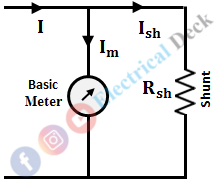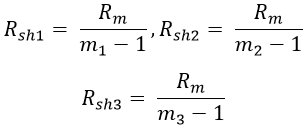There are different types of ammeters used in measuring system to measure current. They are,- Moving Iron Type - Used for measuring both direct and alternating currents
- Permanent Magnet Moving Coil (PMMC) Type - Used for dc measurements only
- Electro-dynamometer Type - Used for measuring both direct and alternating currents
- Rectifier Type - Used for measuring both dc and ac measurements
But every instrument has its measuring range capacity. For example, a moving coil ammeter can measure currents 0-100mA. Thus it is impossible to measure high currents which are more than the measuring range of an instrument. Therefore, it is necessary to bring up these large currents to a value within the range of the instrument.
For extending the range of ammeters, the devices used are shunts or current transformers. Shunts are used for dc and ac measurements while the current transformers are used for ac measuring instruments only. From this, a moving coil ammeter range can be extended by using shunts, and a moving iron ammeter range can be extended by either shunts or current transformer.
Extension of Range of Ammeter using Shunts :
In measuring instrument, shunt refers to a low resistance which is connected in parallel to the basic meter as shown below. It acts as a diverter, and the maximum percent of current measured will be passed through it.
Essential Requirements for the Construction of Shunts :
The essential requirements for the construction of shunts are as follows,- The coefficient of the temperature of the shunt and the instrument coil should be equal as far as possible and should be very low.
- As the maximum percent of current is being diverted through the shunts, they should not produce excess heat.
- Their resistance should be time-invariant.
- In the case of ac instruments, the time constant of the shunt and the instrument coil should be equal.
- They should have low thermoelectric emf with copper.
Let,- Im = Full deflection current of the basic meter
- Ish = Current through shunt
- Rm = Internal resistance of the basic meter
- Rsh = Resistance of the shunt
- I = Current being measured
- m = Multiplying factor
As the shunt is connected in parallel to the basic meter, the voltage drops across the shunt will be equal to that of a basic meter.
Substituting equation 2 in 1 we get,
The ratio of I and Im is called the multiplying factor m.i.e., m = I/Im ...(4).Substituting equation 4 in 3 we get,
The meter deflection θ is directly proportional to the meter current Im.i.e., θ ∝ Im ∝ I So, the meter deflection is directly proportional to the total current being measured. Hence, by connecting a proper value of shunt and calibrating the meter scale in terms of m × Im = I the range of an ammeter can be extended.
Multirange Ammeters :
The range of an ammeter can be extended by using a shunt. Hence, by adding a number of shunts, it can be used as a multirange ammeter and such arrangement is shown below.
It consists of three shunts Rsh1, Rsh2, and Rsh3 which can be used for three different current ranges I1, I2, and I3 respectively. Let the shunt multiplying factors of the currents I1, I2, and I3 be m1, m2, and m3 respectively. Therefore,
Methods of Reducing Errors due to Temperature Changes in the Shunt Connected Instruments :
The errors due to temperature changes in the shunt connected instruments are mainly due to the following reasons. They are,- The temperature of the moving coil and the shunt are not same.
- The moving coil and shunt are not made with the same materials. So, they have different coefficients.
Hence, in order to reduce the temperature errors, the moving coil and shunt must be made up with the same material (which has a negligible coefficient temperature) and they are to be maintained at almost at same temperature which is a difficult task.
In practice, the moving coil is made up and the shunt is made up of manganin. A resistor made up of manganin, with resistance much higher than that of moving coil is connected in series with the moving coil as shown in the below figure. This series resistor is called a swamping resistor.
Due to the changes in temperature, the resistance of the moving coil (Rm) will vary. But, this variation does not affect the current flowing through the meter, because the change in resistance is quite negligible when compared to the total resistance of the moving coil circuit (Rm + Rsw) [∵ Rsw (swamping resistor) >> Rm]. Therefore, the change in the proportion of current divided through the meter and shunt would not be appreciable with the change in temperature.
Extension of Range of Ammeter Using Current Transformer :
For higher current ratings, shunts are not used for moving iron instruments. Shunts have frequency errors and the shunt inductive reactances and coil inductive reactances are very small and high respectively. Thus, current transformers are widely used for ac instruments because most of the moving iron type devices are commonly used for ac measurements.
The secondary of the current transformers arc basically rated at 5 A indefinite of the primary side ratings. The ammeter is connected at the secondary side and the current transformer which is used to extend the range of an ammeter is shown in the figure below.







